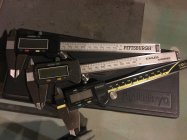I have a lathe which was converted to VFD several years ago. Actually I had a company build me the entire conversion package with all the components and wiring completed, I simply had to install it. So in other words, I don't know all the finer details of the conversion package. It just works, which is what I was after.
I find myself using it more and more lately and I've been wanting to install a DRO. I notice, however, when the machine is running if I lay a digital caliper anywhere on it the caliper gets scrambled, a six inch caliper will read something like 23 inches for example, and has to be re-zeroed before use. I never noticed this before the conversion. No biggie but I wonder if I'm going to have issues with a DRO.
Are there different DRO scales? Magnetic, optical, etc? Just beginning to research this...
I find myself using it more and more lately and I've been wanting to install a DRO. I notice, however, when the machine is running if I lay a digital caliper anywhere on it the caliper gets scrambled, a six inch caliper will read something like 23 inches for example, and has to be re-zeroed before use. I never noticed this before the conversion. No biggie but I wonder if I'm going to have issues with a DRO.
Are there different DRO scales? Magnetic, optical, etc? Just beginning to research this...











